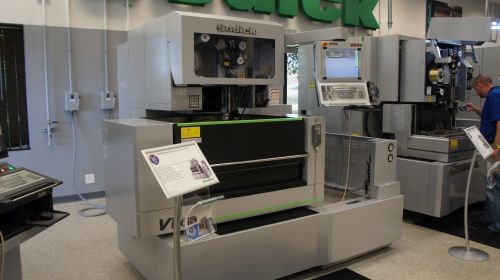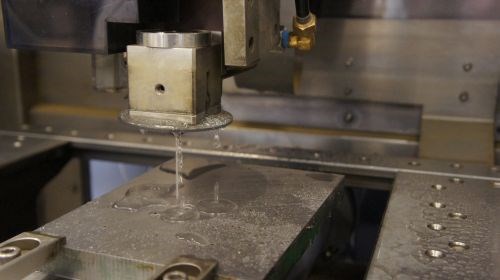EDM Features Longer Travels, Improved Wire Threading
Sodick's latest wire EDM, showcased at a recent open house event, also features linear motors, custom base ceramics and other features common to the company's entire line.

The new VL600Q offers more than just longer travels.
If you’re using EDM technology, chances are your competitors are, too.
That's one reason behind demand for larger machines like Sodick's new VL600Q wire machine, formally introduced in North America at the company's recent "Smart Technology" open house event. So says Alan Losch, applications engineer, who explained that the technology is more accessible than ever, and the days when simply having an EDM could differentiate a shop are long gone. Instead, many try to set themselves apart with larger standard models like the VL600Q, which offers longer travels in all three linear axes than the comparable VZ300L and VZ500L machines (the latter offers travels of 500 x 350 x 250 mm, compared to the VL600Q's 600 x 400 x 270).
Yet, the machine offers advantages beyond longer travels, and many extend throughout the company's entire line. Every machine on the floor at the October 21-22 event—both mills and EDMs alike—was driven by linear motors. According to the company, developing and manufacturing its own motors and accompanying motion control systems is one reason why they can achieve repeatable accuracy within 1 micron. "You can't do that with a ballscrew," Mr. Losch notes, adding that 2016 will be the 10th anniversary of the company's commitment to fully guarantee motion system accuracy for a decade after machine installation. Another feature common to all Sodick machines is a base construction incorporating a custom ceramic material that offers abrasion resistance and a low thermal expansion coefficient (less than one-third that of cast iron).

Displays certainly weren't limited to EDM. This demonstration involved machining highly contoured, gear-like geometry on a linear-motor-driven HS650 VMC.
The VL600Q also serves as a platform for technological advances that are far more recent than the company's longstanding use of linear motors and custom ceramics. For instance, the entire VL line features an updated version of the company’s SuperJet automatic wire threader (AWT). One new capability is the Pop-Up Search function. Previously available only on FixedJet AWTs, this feature uses a stream of air to push the guide—and the wire along with it—upward and away from the hole when threading fails. The process can then be repeated until the wire successfully threads the gap. According to the company, the feature is particularly useful for threading on curved or inclined surfaces and through multiple, in-line holes on stepped/hollow workpieces.
The SuperJet also employs a longer annealing cycle than previous versions, as well as an extra wire contact, to ensure straightness. For the user, this translates to less time spent spent returning to a zero/reference point to rethread, then working the wire back through the cut to pick up where it left off.

This demo of an older version of the wire-threader showcased automatically guiding 0.01-inch wire through holes measuring 0.06 inch in diameter. With an additional wire contact and longer annealing cycle, the new SuperJet is even more capable.
The new wire machine certainly wasn't the only highlight of the "Smart Technology" event, which also featured plenty of sinker and milling displays and presentations from participating partners, including Erowa and OSG USA. Nonetheless, as the company's latest model, it provides an informative look at the technology that's long characterized Sodick machines as well as newer developments.
Related Content
Choosing The Right Grinding Wheel
Understanding grinding wheel fundamentals will help you choose the right wheel for the job.
Read MoreChoosing Your Carbide Grade: A Guide
Without an international standard for designating carbide grades or application ranges, users must rely on relative judgments and background knowledge for success.
Read MoreA New Milling 101: Milling Forces and Formulas
The forces involved in the milling process can be quantified, thus allowing mathematical tools to predict and control these forces. Formulas for calculating these forces accurately make it possible to optimize the quality of milling operations.
Read MoreBuying a Lathe: The Basics
Lathes represent some of the oldest machining technology, but it’s still helpful to remember the basics when considering the purchase of a new turning machine.
Read MoreRead Next
The Cut Scene: The Finer Details of Large-Format Machining
Small details and features can have an outsized impact on large parts, such as Barbco’s collapsible utility drill head.
Read More3 Mistakes That Cause CNC Programs to Fail
Despite enhancements to manufacturing technology, there are still issues today that can cause programs to fail. These failures can cause lost time, scrapped parts, damaged machines and even injured operators.
Read More








.jpg;maxWidth=300;quality=90)





.png;maxWidth=300;quality=90)











.jpg;maxWidth=970;quality=90)